Accepted Scientific Name: Echinopsis tiegeliana (Wessner) D.R.Hunt
Bradleya 9: 88. 1991
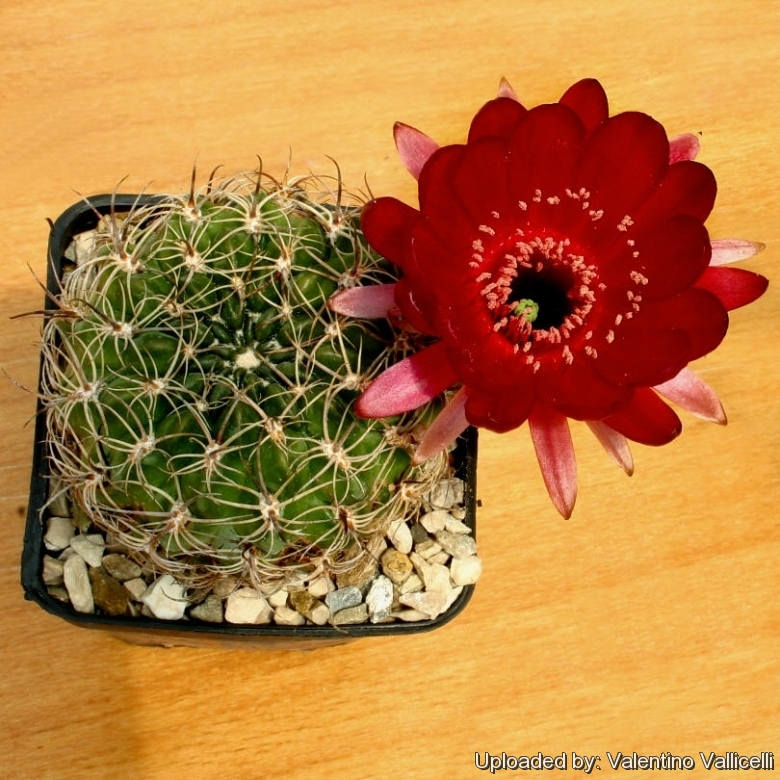
Hymenorebutia tiegeliana (Echinopsis tiegeliana) Photo by: Valentino Vallicelli
Origin and Habitat: Echinopsis tiegelianaSN|20965]]SN|20965]] is endemic to Bolivia, where it occurs in Tarija.
Altitude range: This species grows at altitudes between 1,800 to 2,700 metres above sea level.
Habitat and Ecology: This species occurs in rocky areas amongst shrubby vegetation. It is common where it occurs, but some populations are affected by low-impact subsistence farming and goat herding.
Synonyms:
See all synonyms of Echinopsis tiegeliana
back
Accepted name in llifle Database:Echinopsis tiegeliana (Wessner) D.R.HuntBradleya 9: 88. 1991Synonymy: 34
back
Description: Echinopsis tiegelianaSN|20965]]SN|20965]] (Lobivia tiegeliana) is a small cactus, usually solitary, whose spines looks pectinate ( i.e., its spines are arranged like a comb). This species is very variable in colour and number of spines, size and colour of flowers. It comprises several questionable varieties and its taxonomic history has undergone several changes. The great variability of Echinopsis tiegelianaSN|20965]]SN|20965]] is due to the fact that cross pollination among different forms and different species (in habitat and especially in collections) is very frequent and it can be quite difficult to determine what is the "pure type" and the cross.
Roots: Large fleshy tap root.
Stems: In nature plants usually grow flat with the ground most of the year, contracting under the soil to endure drought periods. In culture plants grow larger forming depressed or spherical stems up to 15 cm in diameter, but usually about 6 cm broad. Epidermis dark green, shiny, often purplish with strong light and in cold weather. The crown is sunken.
Ribs: Approx. 17-20, acute, spirally arranged with raised tubercles between which the areoles appear.
Areoles: White, to 1.5 cm apart.
Spines: Arranged like little spiders, awl shaped, pectinated, variable, reddish, black, brownish, honey or horn coloured , often darker at the tip, turning greyish eventually.
Central spines: As many as 3, pointing downward, to 5 cm long.
Radial spines: 8 to10, 4-6 cm long.
Blooming season: Mature plants produce several waves of blooms over the season. The flowers open during the day. It blooms abundantly since an early age.
Flowers: Lateral 2,5-3 cm long and 4,2 cm in diameter, deep red to violet-pink, although there are varieties with yellow flowers as well.
Fruits: Globose to ovoid, semidry, dehiscent.
Subspecies, varieties, forms and cultivars of plants belonging to the Echinopsis tiegeliana group
Bibliography: Major references and further lectures
1) David Hunt, Nigel Taylor “The New Cactus Lexicon” DH Books, 2006
2) Edward F. Anderson “The Cactus Family” Timber Press, 2001
3) James Cullen, Sabina G. Knees, H. Suzanne Cubey “The European Garden Flora Flowering Plants: A Manual for the Identification of Plants Cultivated in Europe, Both Out-of-Doors and Under Glass” Cambridge University Press, 11/ago/2011
4) David Hunt, Nigel Taylor “The New Cactus Lexicon” DH Books, 2006 ISBN 0953813444, 9780953813445.
5) Walter Rausch "Lobivia 85" Rudolf Herzig Vienna 1985/86 (text in German)
6) Curt Backeberg "Das Kakteenlexikon: Enumeratio diagnostica Cactacearum" Gustav Fischer Verlag, 1979 (text in German).
7) Clive Innes, Clive Times, Charles Glass “The Illustrated Encyclopedia of Cacti” Chartwell Books, 01/apr/2001
8) Willy Cullmann, Erich Götz (Dozent Dr.), Gerhard Gröner “The encyclopedia of cacti” Timber Press, 1987.
9) Lowry, M. 2013. Echinopsis tiegeliana. The IUCN Red List of Threatened Species. Version 2014.3. <www.iucnredlist.org>. Downloaded on 07 May 2015.
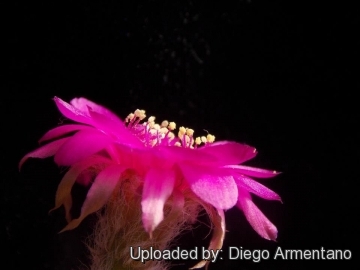 Hymenorebutia tiegeliana (Echinopsis tiegeliana) Photo by: Diego Armentano
Hymenorebutia tiegeliana (Echinopsis tiegeliana) Photo by: Diego Armentano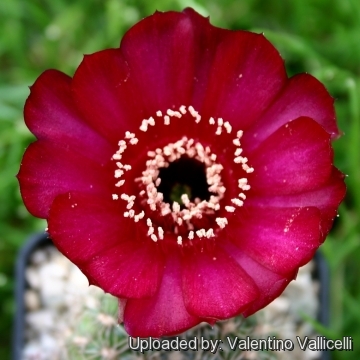 Hymenorebutia tiegeliana (Echinopsis tiegeliana) Photo by: Valentino Vallicelli
Hymenorebutia tiegeliana (Echinopsis tiegeliana) Photo by: Valentino Vallicelli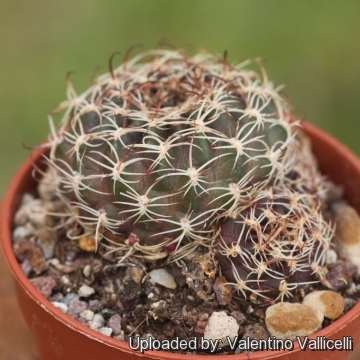 Hymenorebutia tiegeliana (Echinopsis tiegeliana) Photo by: Valentino Vallicelli
Hymenorebutia tiegeliana (Echinopsis tiegeliana) Photo by: Valentino Vallicelli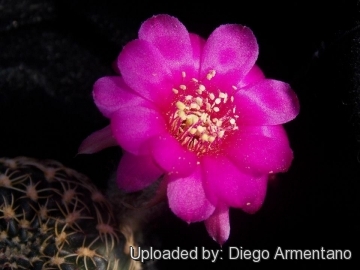 Hymenorebutia tiegeliana (Echinopsis tiegeliana) Photo by: Diego Armentano
Hymenorebutia tiegeliana (Echinopsis tiegeliana) Photo by: Diego Armentano Hymenorebutia tiegeliana (Echinopsis tiegeliana) Photo by: Cactus Art
Hymenorebutia tiegeliana (Echinopsis tiegeliana) Photo by: Cactus ArtSend a photo of this plant.The gallery now contains thousands of pictures, however it is possible to do even more. We are, of course, seeking photos of species not yet shown in the gallery but not only that, we are also looking for better pictures than those already present.
Read More... Cultivation and Propagation: This is a a much decorative frost hardy cactus easily found in cultivation. It is a summer grower species that offers no cultivation difficulties.
Soil: Use a very a particularly draining slightly acidic or neutral substratum, as it is very sensitive to rottenness when in presence of humidity and low temperatures and let the soil dry out between waterings.
Repotting: Repot in the spring, when their roots become cramped. Generally, they should be repotted every other year in order to provide fresh soil. After repotting, do not water for a week or more. Needs a large pot to accommodate a large root system.
Water: In summer, during the vegetative period, it must be regularly watered, but allowing the substratum to completely dry up before irrigating again (but do not overwater ); in winter, it’s to be kept dry. Preferable not to water on overcast days, humid days or cold winter days.
Hardiness: It is a quite frost resistant cactus, hardy to -5° C (- 12° C if very dry). However in cultivation it is better not to expose it to temperatures lower than -0° C, even if in an aerated and protected location, in order to avoid the formation of anti-aesthetic spots on the epidermis. In presence of high atmospheric humidity avoid any frost as it is particularly sensitive to root rot. As these are high-elevation plants, they don't like to get overheated.
Exposure: Outside full sun or afternoon shade, inside needs bright light, and some direct sun, but, as a former mountain dweller, does not care for extremely high temperatures in summer.
Use: It is suitable for small “desert” gardens, in association with other xerophytes. Where the open air cultivation is not possible due to the climate, it is to be cultivated in pot in order to shelter it in winter.
Propagation: Direct sow after last frost or by offsets (if available), provided left drying up well, in summer.
















